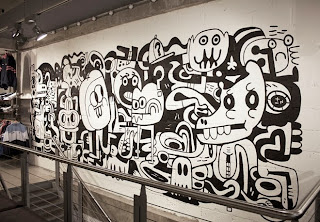Jon Burgerman is an English practitioner living and working in a studio in New York. He doesn't specifically describe himself as an illustrator, but an artist, as his work is not specific easily defined.
He studied Fine Art at Nottingham Trent University in the early 2000s, but felt like his work never fitted in under that bracket, as his work is very self driven trying to make interesting things in a predominantly flat/visual medium.
He stated that he doesn't really have a specific 'style'. Instead Burgerman works within a platform that encourages people to create work of their own as a sort of 'I could do that, maybe I could create my own version' knock on effect.
Burgermans projects are very playful taking a wide breadth of approaches to each. He emphasised the fact that that he doesn't just do work within his studio, 'your studio is everywhere', an example of this being the 'Headshots' project responding to advertisements which used guns in Korean subways.
One of the most extravagant things Burgerman said he had don't is move to New York. It was kind of a spur of the moment decision thing for him as he wanted to get away from himself and have a challenge, so he literally packed his bags and got on the plane. His first thoughts on arrival were, "FUCK WHAT HAVE I DONE!?", but in time that feeling wore off.
He has come to realise the meaning of success too. Many people have different opinions as to what success is, and this is what he stated: "Success is waking up happy and wanting to do stuff. Having fun in daily life". Which is very important, as most people would associate success with having a lot of money. I admire this 'real world' approach of his.
The importance of drawing:
- Everything starts from drawing
- Take pen and paper wherever
- David Lynch- having a powerful image in the mind.
- Allowing things to be more RAW.
What Jon Burgerman would have said to his first year self:
Wear nicer clothes, never undervalue a haircut...
Don't worry about where things fit in. No one judges what you're making. Play around and see what happens.
Finally, What defines a good piece of work:
'You just know, it has to be on your wavelength'. Its not always immediate. Your friends will appreciate it, and it just clicks because its a joy to make.








